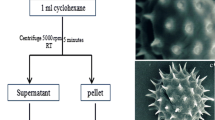Summary
The aim of the present study has been to elucidate the cytology of the glandular stigma inLycopersicum peruvianum Mill. and the mechanism of the secretory process during the stigma development.
The glandular stigma (papillae and superficial stigmatic tissue) has been studied by light and electron microscopy (S.E.M. and T.E.M.).
At anthesis, the longitudinal intercellular spaces are filled with exudate in the form of heterogeneous droplets and form an intercommunicating system which allows transmitting tissue to communicate with superficial papillae.
The presence of cytoplasmic droplets similar in appearance to the exudate has been noted in the developing stigmatic tissue. Cytoplasmic events which may be related to their production include transitory vacuolar accumulations, modifications of the morphology of plastids and development of smooth endoplasmic reticulum. At anthesis, observations possibly related to the origin of these droplets include their contiguity with endoplasmic reticulum cisternae and their relationship to the Golgi apparatus.
Some observations suggest that cytoplasmic droplets are extruded by a process of exocytotic secretion. In addition, the cytoplasmic transport of secretory products in a non-visible form may explain the involvement of several cell compartments and the heterogeneity of the secretory products.
Similar content being viewed by others
References
Amelunxen, F., Arbeiter, H., 1967: Untersuchungen an den Spritzdrüsen vonDictamnus albus L. Z. Pflanzenphysiol.58, 49–69.
Carde, J. P., 1976: Evolution infrastructurale du système sécréteur des canaux dans les aiguilles du Pin maritime. Soc. bot. Fr., Coll. Sécrét. végét.123, 181–189.
Casadoro, G., Rascio, N., Paganelli Cappelletti, E. M., 1977: Membrane-bound plastidial inclusions in Belladona (Atropa belladonna L.). Biol. Cell.29, 61–66.
Charriere-Ladreix, Y., 1976: Répartition intracellulaire du sécrétat flavonique dePopulus nigra L. Planta129, 167–174.
Cresti, M., van Went, J. L., Pacini, E., Willemse, M. T. M., 1976: Ultrastructure of transmitting tissue ofLycopersicum peruvianum style: development and histochemistry. Planta132, 305–312.
Dumas, C., 1974: Some aspects of stigmatic secretion inForsythia. In: Fertilization in higher plants (Linskens, H. F., ed.), pp. 119–126. Amsterdam-Oxford-New York: North-Holland Publ. Co., American Elsevier.
-1975: Le stigmate et la sécrétion stigmatique: étude histophysiologique, cytologique et biochimique de l'activité glandulaire lipophile. Thèse Doctorat d'Etat, Lyon.
—,Lecocq, M., 1975: Mise en évidence et observation de la sécrétion stigmatique, au microscope électronique à balayage, à l'aide d'une technique adaptéee du « freeze-drying ». C. R. Acad. Sci. (Paris)280, 837–840.
—, 1977: Etablissement d'un modèle de la cinétique de la sécrétion lipopolyphénolique du stigmate deForsythia intermedia Zabel C. R. Acad. Sci. (Paris)284, 1777–1779.
Gaertner, C. F., 1844: Beiträge zur Kenntnis der Befruchtung der vollkommenen Gewächse. Versuche und Beobachtungen über die natürliche und künstliche Befruchtung durch den eigenen Pollen. 1–644. Stuttgart: E. Schweizerbart.
Heslop-Harrison, J., 1975: Incompatibility and the pollen stigma interactions. Ann. Rev. Plant Physiol.26, 403–425.
Konar, R. N., Linskens, H. F., 1966 a: The morphology and anatomy of the stigma ofPetunia hybrida. Planta71, 356–371.
— —, 1966: Physiology and biochemistry of the stigma fluid ofPetunia hybrida. Planta71, 372–387.
Kroh, M., 1967: Bildung und Transport des Narbensekrets vonPetunia hybrida. Planta77, 250–260.
Lüttge, U., Schnepf, E., 1976: Organic substances. In: Transport in plants, II, part B. Tissues and organs (Lüttge, U., Pitman, M. G., eds.), pp. 244–277. Berlin-Heidelberg-New York: Springer.
Nettancourt, D. de, 1977: Incompatibility in angiosperms. Monographs on Theor. Appl. Gen.3. Berlin-Heidelberg-New York: Springer.
Reeve, R. M., 1951: Histochemical tests for polyphenols in plant tissues. Stain Technol.26, 91–96.
Rosen, W. G., 1975: Pollen pistil interactions. In: Biology of the male gamete,7 (Duckett, J. G., Racey, P. A., eds.), pp. 153–164. London: Academic Press.
Schwarzenbach, A. M., 1971 a: Aleurovakuole and Sphärosomen im Endosperm vonRicinus communis während der Samenreifung und Keimung. Ber. Schweiz. bot. Ges.81, 70–91.
—, 1971 b: Observations on spherosomal membranes. Cytobiologie,4, 145–147.
Schnepf, E., 1969: Sekretion und Exkretion bei Pflanzen. ProtoplasmatologiaVIII (8), Wien-New York: Springer.
Author information
Authors and Affiliations
Additional information
Research partially supported by C.N.R.S. “R.C.P. 429” and by C.N.R. programme “Biology of reproduction”.
Rights and permissions
About this article
Cite this article
Dumas, C., Rougier, M., Zandonella, P. et al. The secretory stigma inLycopersicum peruvianum Mill.: Ontogenesis and glandular activity. Protoplasma 96, 173–187 (1978). https://doi.org/10.1007/BF01279584
Received:
Accepted:
Issue Date:
DOI: https://doi.org/10.1007/BF01279584




